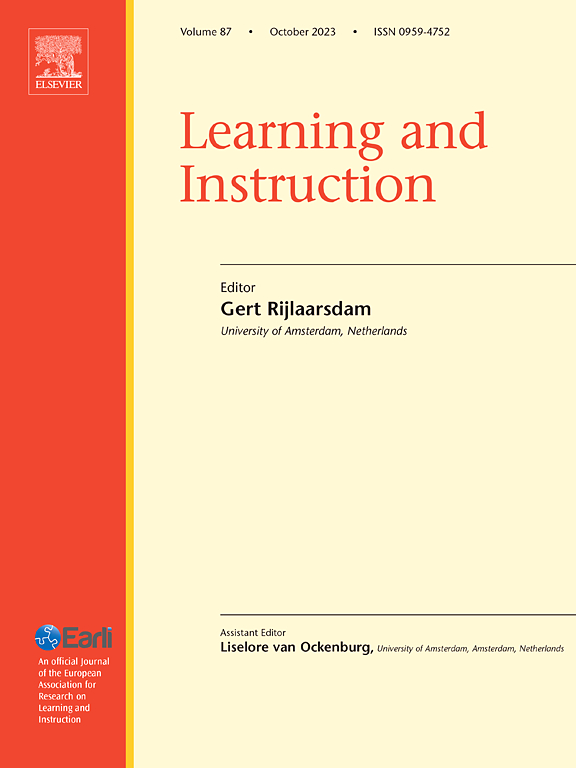Distilling playful stances to learning: Looking across cultures, contexts, roles and generations
IF 4.7
1区 教育学
Q1 EDUCATION & EDUCATIONAL RESEARCH
引用次数: 0
Abstract
The potential of play for socio-cognitive development and learning has received scholarly attention for many decades. Nonetheless, the role of play in education and the nurturing of playful approaches is mostly restricted to studies of the early years, extra curricular learning spaces, and introductory or accessory phases in learning cycles and educational practices. This demarcation becomes more acute as the achievement-centred demands and globalised standards of competitive societies increasingly permeate educational systems and practices. In this scenario, play and playfulness appear as a neglected or encapsulated area, divorced from the contemporary global agenda of learning and instruction. Rather than advocating a return to the roots or calling for more space for play in academic schedules, this Special Issue seeks to advance the international agenda around playfulness and show that through re-envisioning the concept, new insights can be garnered in contemporary times. Eleven contributions from north to south and east to west deploy fine-grained methodologies to delve into how and why playfulness can enhance children's, teachers', youth's and adults' learning at school, university and in more open spaces. The collection of papers contributes a more precise understanding of the specific qualities that sustain the experience of playfulness and, on that basis, enable creative, agentic and pleasurable ways of learning in ecologically relevant fields.
The issue surfaces new directions for research, that include for example extending the focus of playfulness to secondary and higher education contexts as well as wider populations. Specifically such work could seek ways that alleviate the academic pressures and prioritisation of knowledge reproduction as well as flesh out how playfulness can sustain and enrich the learning horizons of those with neurodivergent trajectories and needs. In order to advance a more nuanced understanding of the affordances of playfulness in learning, we also need to disentangle how different senses and experiences of play contribute to different ways and rhythms of learning. And develop a deeper appreciation of the multiple ways in which imagination and reality feed each other in playful learning, both across and beyond educational curricula.
从有趣的角度提炼学习:跨越文化、背景、角色和世代
几十年来,游戏对社会认知发展和学习的潜力一直受到学术界的关注。然而,游戏在教育中的作用和游戏方法的培养主要局限于早期的研究、课外学习空间、学习周期和教育实践的入门或辅助阶段。随着以成就为中心的要求和竞争社会的全球化标准日益渗透到教育系统和实践中,这种划分变得更加尖锐。在这种情况下,游戏和玩乐似乎是一个被忽视或被封装的领域,脱离了当代全球学习和教学议程。本期特刊并不是提倡回归本源,也不是呼吁在学术安排中为玩耍留出更多空间,而是试图推动围绕玩耍的国际议程,并表明通过重新构想这一概念,可以在当代获得新的见解。从北到南、从东到西的11个贡献采用了精细的方法,深入研究了玩耍如何以及为什么可以促进儿童、教师、青年和成人在学校、大学和更开放的空间的学习。论文的收集有助于更精确地理解维持游戏体验的具体品质,并在此基础上,在生态相关领域中实现创造性,积极性和愉快的学习方式。这一问题提出了新的研究方向,包括将玩乐的重点扩展到中学和高等教育背景以及更广泛的人群。具体来说,这样的工作可以寻求减轻学术压力和知识复制优先级的方法,以及充实玩耍如何维持和丰富那些具有神经发散轨迹和需求的人的学习视野。为了更细致地理解学习中的游戏性,我们还需要弄清楚不同的游戏感觉和体验是如何影响不同的学习方式和节奏的。并培养对想象力和现实在有趣的学习中相互滋养的多种方式的更深刻的认识,无论是在教育课程中还是在教育课程之外。
本文章由计算机程序翻译,如有差异,请以英文原文为准。
求助全文
约1分钟内获得全文
求助全文
来源期刊

Learning and Instruction
Multiple-
CiteScore
11.30
自引率
4.80%
发文量
109
期刊介绍:
As an international, multi-disciplinary, peer-refereed journal, Learning and Instruction provides a platform for the publication of the most advanced scientific research in the areas of learning, development, instruction and teaching. The journal welcomes original empirical investigations. The papers may represent a variety of theoretical perspectives and different methodological approaches. They may refer to any age level, from infants to adults and to a diversity of learning and instructional settings, from laboratory experiments to field studies. The major criteria in the review and the selection process concern the significance of the contribution to the area of learning and instruction, and the rigor of the study.
 求助内容:
求助内容: 应助结果提醒方式:
应助结果提醒方式:


